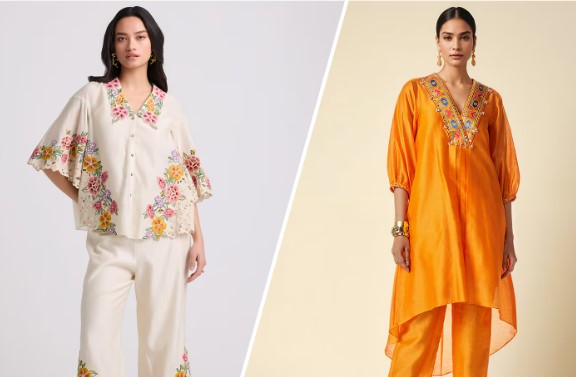Traditional Indian wear offers a variety of silhouettes that blend comfort with elegance, and the kurta and kurti are among the most popular choices. While they may look similar at first glance, subtle differences in their design, length, and styling set them apart. Both have evolved over time to suit modern fashion sensibilities, with new fabrics and patterns making them versatile wardrobe staples. Understanding these differences helps in choosing the right style for the right occasion.
Modern Twist on Tradition – Denim Kurtis
Denim kurtis have become a contemporary favourite for women who prefer a fusion of traditional and western styles. Typically shorter in length than kurtas, kurtis often fall between the waist and mid-thigh, making them perfect for pairing with jeans, leggings, or even skirts. Denim adds a casual, chic edge, making these kurtis ideal for outings, college wear, or even casual Fridays at work.
Styling denim kurtis is simple yet versatile. You can pair them with contrasting trousers for a smart-casual look or wear them over palazzos for a more relaxed vibe. Minimal accessories such as hoop earrings and comfortable flats complement the look without overpowering it.
Longer and More Traditional – Denim Kurtas
Denim kurtas, on the other hand, usually have a longer length, extending below the knee or even to the ankles. This length makes them more suited for semi-formal events, festive gatherings, or traditional occasions. While kurtas are traditionally made from cotton, silk, or blended fabrics, denim kurtas bring a modern update to the silhouette, offering durability and a structured drape.
A denim kurta can be styled with churidars, straight trousers, or even wide-leg palazzos for a sophisticated appearance. Pairing them with statement jewellery and embroidered juttis can add a festive touch, while keeping accessories minimal makes them perfect for office wear.
Length and Fit Differences
One of the key differences between a kurta and a kurti lies in their length. Kurtas are generally longer, often flowing well below the knees, while kurtis tend to be shorter, offering more scope for pairing with a variety of bottoms. The fit can also vary—kurtas often feature a more traditional straight cut, while kurtis may come in A-line, asymmetrical, or flared designs.
This variation in length and fit also affects their styling. While a kurta can create a more formal or traditional impression, a kurti often feels more casual and contemporary.
Occasions and Versatility
Both kurtas and kurtis are versatile, but their suitability often depends on the occasion. Kurtas are ideal for formal gatherings, cultural events, or festive celebrations, especially when paired with traditional accessories. Kurtis, on the other hand, are better suited for daily wear, casual meet-ups, and office environments that embrace a smart-casual dress code.
Fusion styles are also gaining popularity—pairing a traditional kurta with sneakers for a modern look, or wearing a denim kurti with statement belts for a trendy twist.
Fabric and Styling Trends
While traditional fabrics remain popular, modern variations like denim have made these garments more adaptable to western styling. Denim kurtis offer a playful, youthful feel, while denim kurtas provide a more structured, sophisticated look. Both can be dressed up or down depending on the accessories, footwear, and layering choices.
Lightweight scarves, statement earrings, and versatile footwear like block heels or flats can enhance the overall look, whether you’re wearing a kurta or a kurti.
Final Thoughts
The kurta and kurti share cultural roots but differ in length, fit, and overall styling possibilities. Denim kurtis bring a casual, modern flair suitable for everyday wear, while denim kurtas offer a refined, contemporary take on a traditional silhouette. By understanding these differences, you can choose the right style for the right occasion and make the most of these timeless yet ever-evolving garments.

